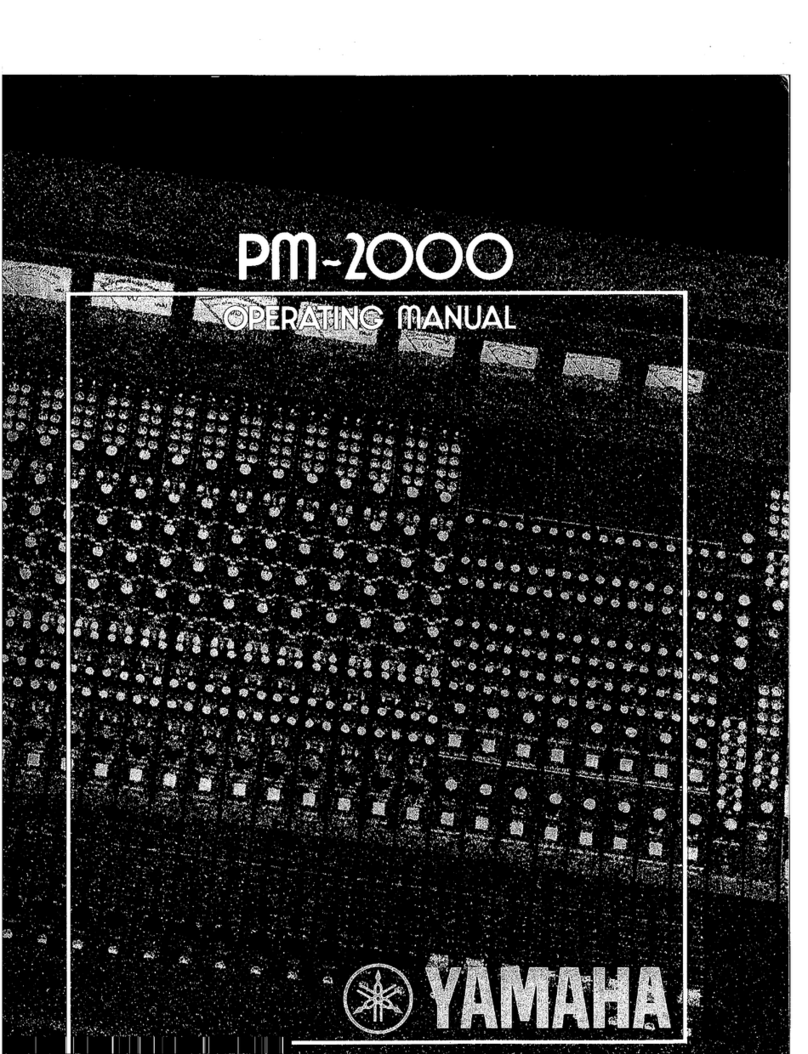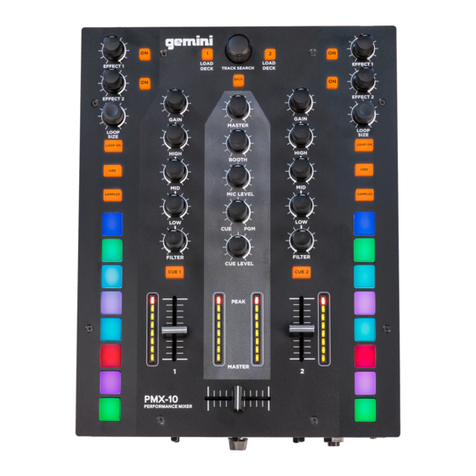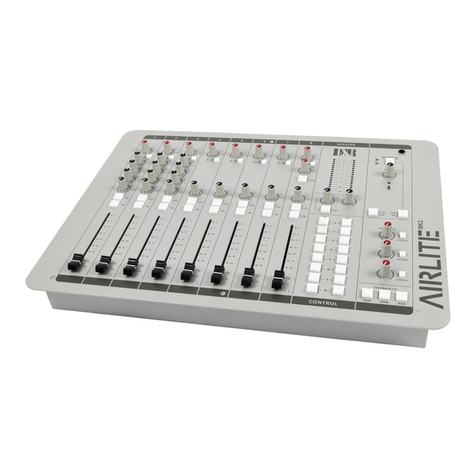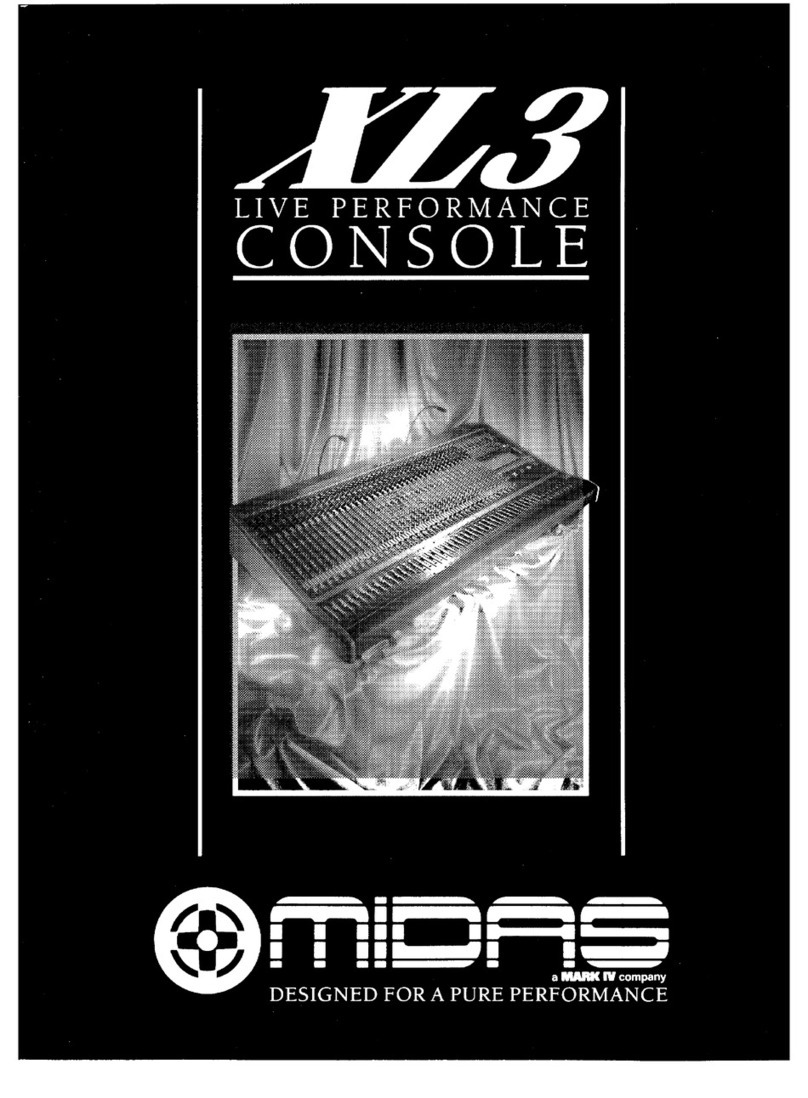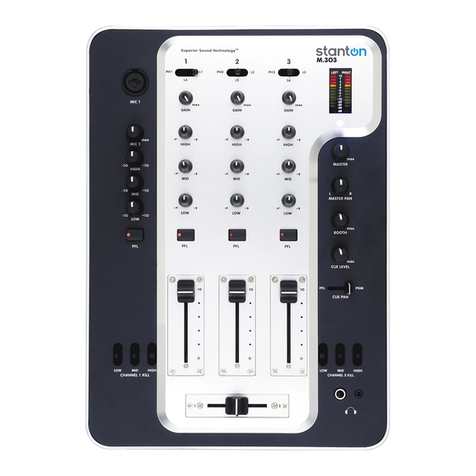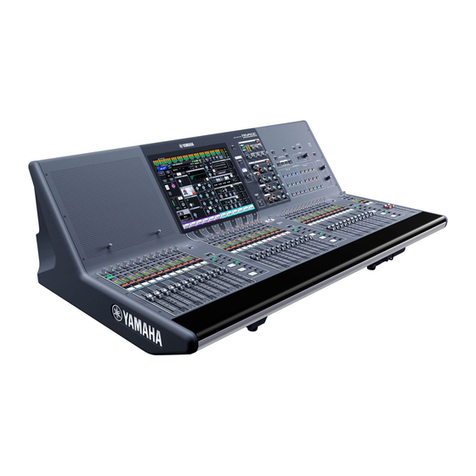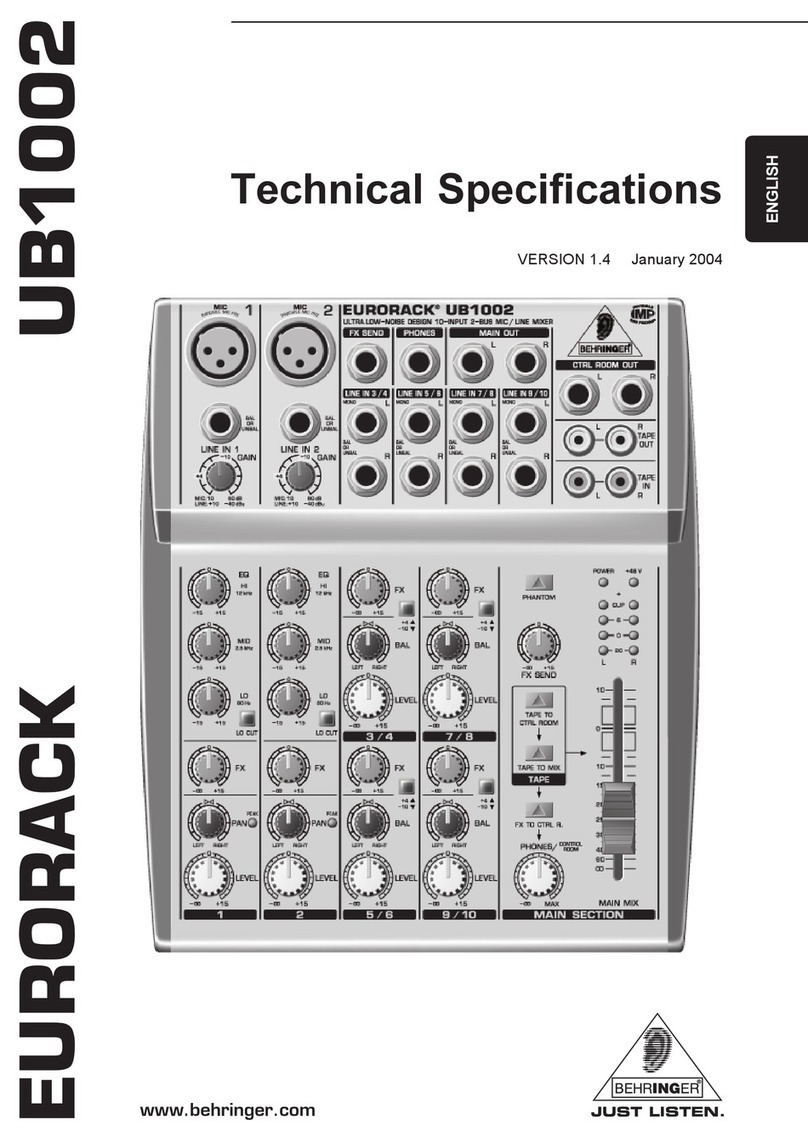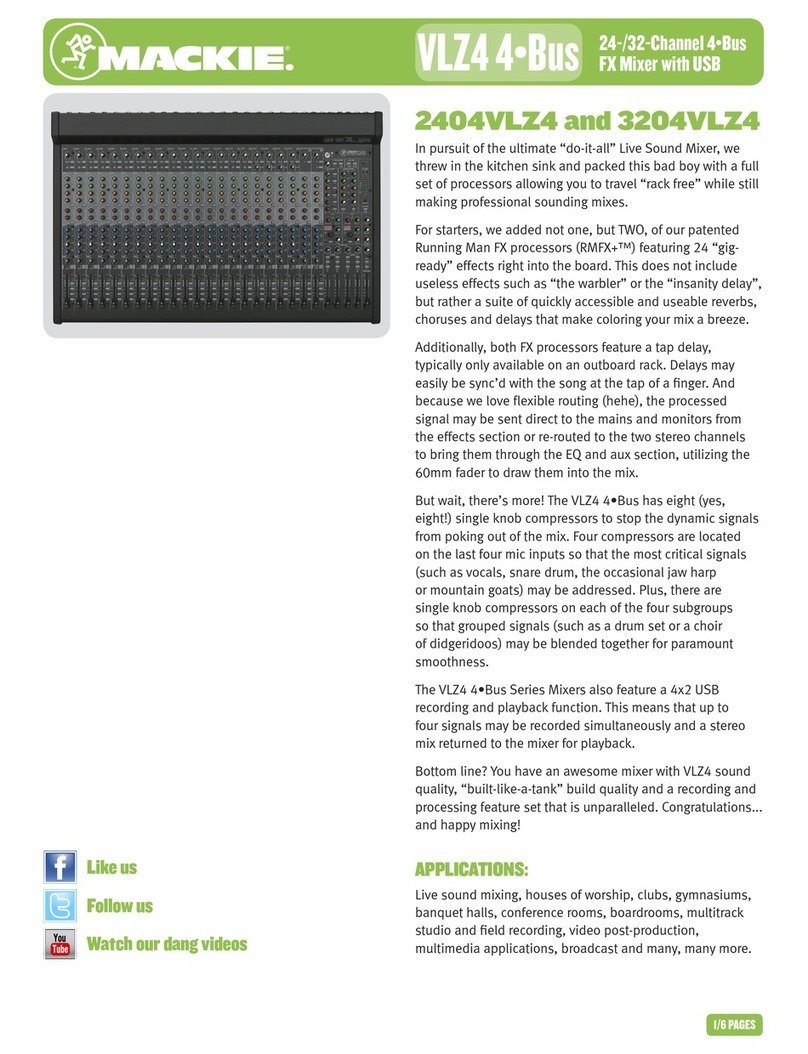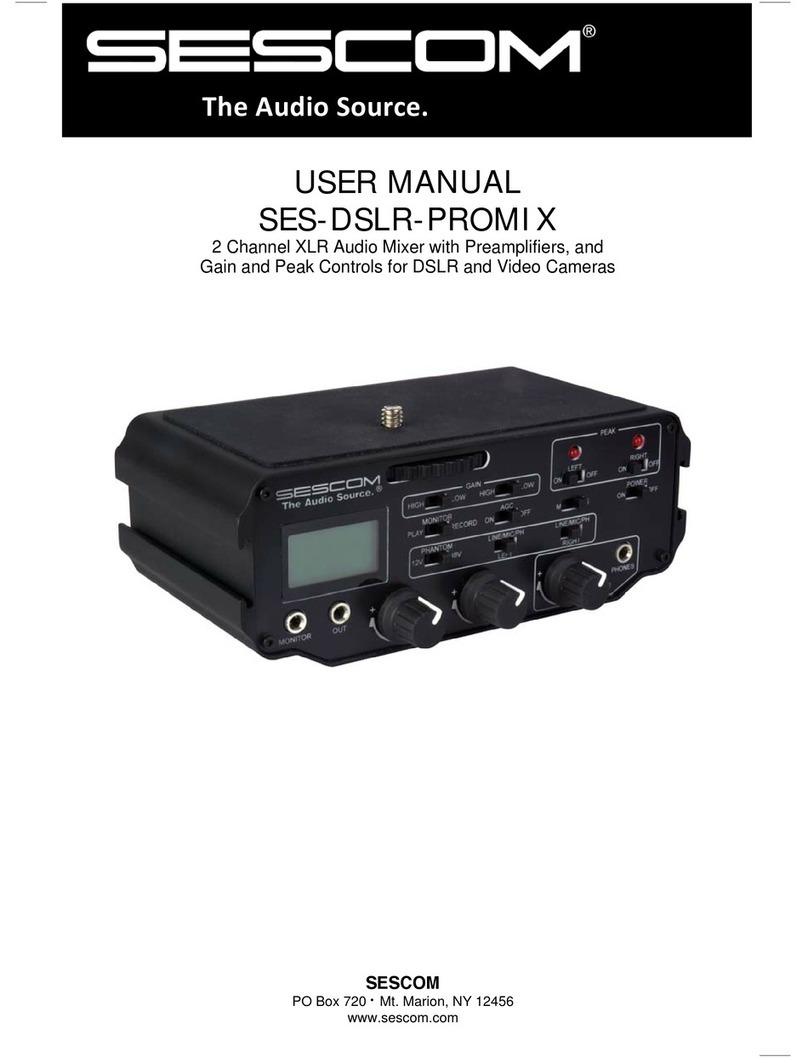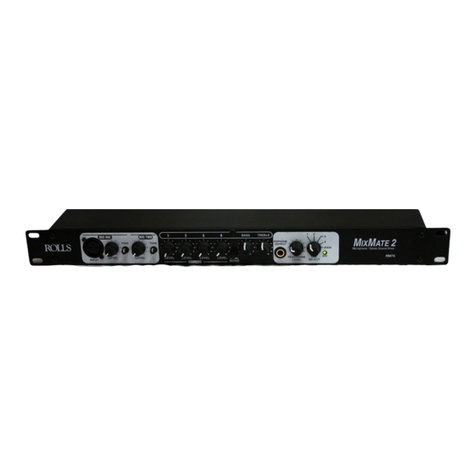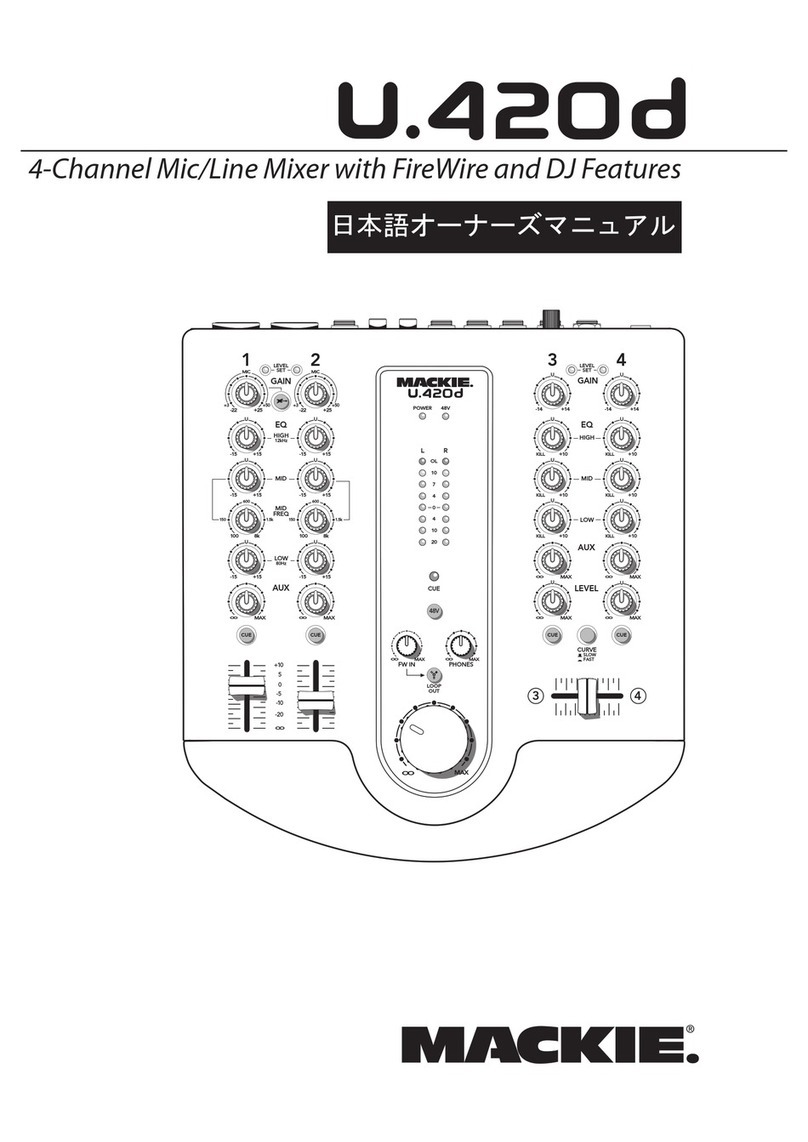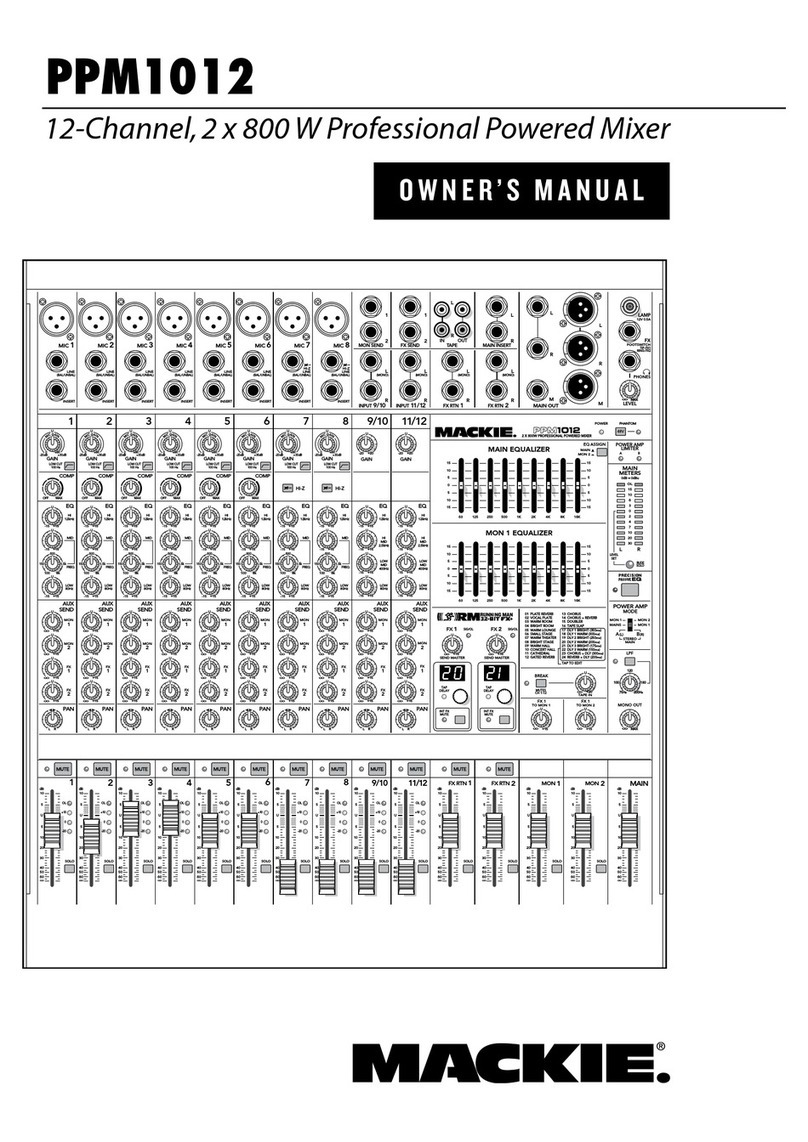CPI TRML Series User manual

Instruction Manual
CPI Communications 941 Hensley Lane Wylie, Texas 75098
Phone (972)429-7160 (800)869-9128 Fax (972)429-7165 (888) 437-5360 www.cpicomm.com
TRML Series
Multi-Line Tone Remote
01/2013

TABLE OF CONTENTS
SPECIFICATIONS 4
GENERAL DESCRIPTION 5
FRONT PANEL CONTROLS AND INDICATORS 6-7
INSTALLATION
POWER 8
PHONELINES 8
LOCAL CONTROL CONTACT CLOSURES 8
DESK MIC 9
HEADSET 9
FOOTSWITCH 9
EXTERNAL SPEAKER 9
PARALLEL OPERATION 9
Line Impedance 10
Crossmute 10
LEVEL SETTINGS
Microphone Sensitivity 10
Earpiece Adjust 10
Rx Audio Line Input 10-11
Tx Line Output
Notch Filters 11-12
12
PROGRAMMING
ENTERING PROGRAMMING 13
ENABLING/DISABLING LINE SELECT BUTTONS 13
ENABLING/DISABLING SELECT ALL BUTTON 13
EXIT PROGRAMMING 13
OPERATION
SELECTING A LINE 13
SELECTING MULTIPLE LINES 13
SELECTING A FREQUENCY 14
TRANSMITTING/INITIATING CALLS 14
INTERCOM 14
RECEIVING CALLS 14
MUTING A LINE 14
PRIVACY 14
DIP SWITCH AND JUMPER SETTINGS
MISC.DIP SWITCH -BASE BOARD 15
LINE IMPEDANCE DIP SWITCH -MIDDLE BOARD 15
PARALLEL AUDIO DIP SWITCH -MIDDLE BOARD 15
LINE ACTIVITY DIP SWITCH -MIDDLE BOARD 16
2WIRE &4WIRE /RX AUDIO OPTIONS JUMPERS -MIDDLE BOARD 16
FOOTSWITCH PTT JUMPER -MIDDLE BOARD 16
MISC.SOLDER JUMPERS -BASE BOARD 16-17
MISC.SOLDER JUMPERS -TOP BOARD 17

AUDIO CONTROLS
LINE AUDIO -MIDDLE BOARD 17
MISC.AUDIO -BASE BOARD 17
PICTORIALS
BACK VIEW 18
WARRANTY 19
SCHEMATICS AND BOARD LAYOUT
AUDIO CONTROL LOCATIONS
BASE BOARD 20
21-25
MIDDLE BOARD 26-35
TOP BOARD 36-39
Parts List
BASE BOARD 40-42
MIDDLE BOARD 43-44
TOP BOARD 45-46
MISC 47

TRML REMOTE CONTROL CONSOLE
4
SPECIFICATIONS subject to change without notice
Power Requirements 120VAC, 60Hz for wall pack (provided). Fused on circuit board.
Dimensions 9.5” x 4” x 7”
Weight TRML - 4.5lbs, with Deskmic Option - 5.2lbs
Audio Output to Speaker 2 Watts at 3% THD into 8 ohms, using supplied wall pack or
Handset Earpiece Level Adjustable via internal potentiometer
Frequency Response +/- 3dB from 300 to 3000Hz, except at notch frequency. 1000Hz reference.
Hum and Noise 50dB below operating levels
Transmit Notch Filter 2175Hz down 50dB from 1000Hz reference level
Receive Notch Filter 2175Hz down 50dB from 1000Hz reference level
Transmit Audio Compression Less than 3dB increase in output with 30dB increase in input beyond threshold.
Receive Audio Compression Less than 3dB increase in output with 30dB increase in input beyond threshold.
Threshold is adjustable from -24dBm to +15dBm.
Line Impedance 2 wire: 600 ohms or 2.4k ohms, dip switch selectable per line
4 wire: 600 ohms or 10K ohms, dip switch selectable per line
Line Output Level Factory set at 0dBm. Adjustable to +10dBm maximum
Control Tone Frequencies Guard Tone: 2175Hz @ +10dBm for 140ms
Function Tone: F1 1950Hz @ 0dBm for 40ms
F2 1850Hz@ 0dBm for 40ms
F3 1750Hz @ 0dBm for 40ms
F4 1650Hz @ 0dBm for 40ms
F5 1550Hz @ 0dBm for 40ms
F6 1450Hz @ 0dBm for 40ms
F7 1350Hz @ 0dBm for 40ms
F8 1250Hz @ 0dBm for 40ms
Monitor Tone: 2050Hz @ 0dBm for 40ms
Hold Tone: 2175Hz @ -20dBm for duration of PTT
Operating Modes Standard: Two wire simplex per line
Optional: Four wire simplex per line, Four wire duplex per line
Maximum Parallel Remotes 10 remotes per line
Connections Phone lines: 8 pin RJ45 modular jacks - TIA/EIA T568-B
Relay Outputs: 8 pin RJ45 modular jacks - TIA/EIA T568-B
Handset: 4 pin modular jack
Deskmic: 6 pin modular jack
Headset: 6 pin modular jack
Gooseneck: 3 pin plug, screw lock connector
Power: 3 pin EN3® weather tight locking connector

TRML REMOTE CONTROL CONSOLE
5
GENERAL DESCRIPTION
The TRML series multi line tone remote allows users to reliably control up to four separate conventional and/or
trunked two way base stations and/or repeaters via twisted pair wiring. One TRML remote allows users to
communicate on 4 separate radios individually or a combination of 2 to 4 radios simultaneously. Incoming receive
audio signals are controlled by independent select and unselect audio controls with the capability of each line being
muted.
Programmable features include line enable/disable and select all enable/disable. The TRML does not require
additional software for programming. Data is stored in a nonvolatile EEPROM and will retain the data when power
is lost. Programming is accomplished using the standard front panel buttons on the face of the remote allowing
fully field programmability.
When a PTT occurs from the handset, front panel, optional desk mic, optional gooseneck, or optional headset
interface the other mics will mute to eliminate background noise during the transmission. Receive audio is
transferred to the handset earpiece when taken off hook.
Parallel Status Indication allows the remote to update when a channel change function is performed from another
remote on the system. The TRML activates the Parallel Transmit Indication (PTI) by lighting the TX LED when
parallel remotes key and can also be configured to mute the speaker by enabling the crossmute function to prevent
audio feedback when remotes are in close proximity.
Standard features include volume controls for selected and unselected lines, individual activity line indicators, front
panel PTT switch, LED transmit indicator, monitor function with LED indicator, intercom function with LED indicator,
select all function with indicator, individual receive mute switches with LED indicators, receive and transmit audio
compression, 2175Hz transmit and receive notch filters, PTI indication, crossmute, 2 wire and 4 wire selection per
line, locking quick disconnect power supply, and RJ45 connections to termination panels.
The TRML is available in many optional configurations. Some of the available options include: (-DM) Desk mic in
addition to handset, (-GN) Gooseneck mic replaces the handset, (-FS) Foot switch to activate PTT, (-CC) Contact
Closure PTT relay output, (-8F) Eight frequency control per line, (-SPK/JACK) 3.5mm jack for amplified speaker,
and (-SPKR) Speaker (external, amplified, requires 12VDC).

TRML REMOTE CONTROL CONSOLE
6
FRONT PANEL CONTROLS AND INDICATORS
TRML
LINE 1 LINE2 LINE 3 LINE 4
F1 F2 F3 F4
F6
F5 F7 F8
LINE ACTIVITY
RX MUTE
RX MUTE RX MUTE
RX MUTE
MONITOR
INTERCOM
PRIVACYSELECT ALL
TX
VOLUME
SEL
UNSEL (Programming Display)
TRML
LINE 1 LINE2 LINE 3 LINE 4
F1 F2 F3 F4
F6
F5 F7 F8
LINE ACTIVITY
RX MUTE
RX MUTE RX MUTE
RX MUTE
MONITOR
INTERCOM
PRIVACYSELECT ALL
TX
VOLUME
SEL
UNSEL (Programming Display)
Figure 1 - Front Panel
Front panel
Figure 1 shows a view of the front panel of the TRML series. The front panel features line activity indicators, line
selection, Rx mute per line, select all line function, intercom and monitor functions, Tx function, and volume controls
for selected and unselected audio. Optional eight channel frequency selection is available on the TRML-8F. The
programming display and Privacy button are for future applications and/or special applications. All functions and
features include indicators except the volume controls.
Controls and Indicators
LINE ACTIVITY indicators: Orange LED’s located above each LINE button will light indicating Rx audio activity on
that line. The orange activity indicators remain lit while audio is present and for 3 seconds (factory default) after
audio is absent.
LINE1-LINE4 Buttons: Selects one of four lines to be the selected line and is indicated by green a LED. When
one line is selected, the previous selected line is canceled. Only one line can be selected unless Select All is
activated, which then any combination of lines can be selected and/or unselected to be transmitted on.
RX MUTE Button: Mutes and unmutes incoming Rx audio, of the above respective Line button, from being
monitored on the handset or speaker and lights a green LED to indicate the line is muted.
F1-F8 Buttons: Selects frequency and sends corresponding function tone on the selected line. When a frequency
is selected, it lights the frequency LED. Selection will remain on last selected frequency until a different frequency
is selected regardless of other remote functions.

TRML REMOTE CONTROL CONSOLE
7
SELECT ALL Button: Allows user to select multiple lines to transmit on. Once the button has been pressed, a
green LED shows the Select All function has been activated and the user can now select and unselect desired lines
using the LINE1-LINE4 buttons. The last selected line before entering into the Select All mode is still controlled by
the Selected Volume control and the other lines are controlled by the unselected volume control.
PRIVACY Button: Non operational. Reserved for future applications.
INTERCOM Button: When pressed and held, provides intercom capability to other parallel remotes on the selected
line(s) without keying the radio. A yellow LED will light as long as the intercom button is pressed.
MONITOR Button: Sends the monitor tone burst, on the selected line, placing the radio into monitor mode to
disable coded squelch (CTCSS/CDCSS) so the line may be monitored before transmitting. A green LED lights as
long as the monitor button is pressed.
TX Button: When pressed and held, allows the user to key the radio and transmit on selected lines. A red TX LED
lights as long as the button is pressed. The TX LED also lights when any PTT occurs from the TRML and will also
light as a parallel transmit indication (PTI) that parallel remotes on the selected line are currently transmitting.
SEL Volume Control: Adjusts the speaker level of the Selected audio when the remote is set to control volumes
independently or adjusts the speaker level of the summed Selected and Unselected audio when the remote is set
to control both.
UNSEL Volume Control: Adjusts the speaker level of the Unselected audio.
Programming Display: Non operational. Reserved for future applications.

TRML REMOTE CONTROL CONSOLE
8
INSTALLATION
The TRML series tone remote will operate with any remote system using the EIA standard tone control format.
Power
The remote is powered from 120V 60Hz AC using the supplied wall pack transformer. In most cases, when the
supplied wall pack is used, a standard grounded outlet is acceptable. An ideal ground point would consist of a ½
inch copper rod driven six feet into the earth with at least a #16 AWG copper wire connecting it to the GND terminal
of the remote, taking the shortest path possible.
Phone lines
The TRML is designed to work with a high quality voice grade circuit such as leased lines or in-house twisted pair
wiring for each line used. Circuits and wiring must have no dial tone, talk battery, or signaling. DC continuity is not
required.
Connections are made to the remote, via the supplied 6 foot modular Cat5/5e/6 cable, to J5 for two wire operation
and to J4 and J5 for four wire operation. J5 provides Tx and Rx connections for two wire lines. J4 provides Tx
connections and J5 provides Rx connections for four wire lines. Figure 2 shows the back views of J5 and J4. The
TRML comes standard with jumper selectable two wire or four wire operation. The TRML is shipped from the
factory in the two wire mode. Refer to Table 3 to configure jumpers for four wire mode.
Two Wire Four Wire/Full Duplex
L3 Tx/Rx
Figure 2 - Phone line Connections
Local Control Contact Closure (-CC option)
The optional local control contact closure provides a normally open dry relay contact closure during PTT on each
individual line. The relay is not activated during intercom. Each relay can be also be configured to close to ground
by installing 2.7 ohm resistors in R180, R179, R178, R177 on the middle board for Lines 1, 2, 3, 4, respectively.
Figure 3 shows the back view of J3.
Figure 3 - Contact Closure Connection
J5
1
2
3
4
5
6
7
8
L1
Tx/Rx
L2 Tx/Rx L4 Tx/Rx
L3 Rx
J5
1
2
3
4
5
6
7
8
L1 RxL2 Rx L4 Rx
L3 Tx
J4
1
2
3
4
5
6
7
8
L1 Tx
L2 Tx L4 Tx
Local 1 +
Local 1 -
J3
1
2
3
4
5
6
7
8
Local 3 -
Local 3 +
Local 4 +
Local 2 -
Local 4 -
Local 2 +

TRML REMOTE CONTROL CONSOLE
9
Desk Mic (-DM option)
The optional Desk Mic feature provides connections to accommodate a CPI desk mic for console use. Figure 4
shows the back view of J2.
Desk Mic PTT
unused
Figure 4 - Desk Mic Connection
Headset (-HS Box option)
The optional headset input provides availability to directly connect the CPI headset box (sold separately) for hands
free dispatch operation when paired with a compatible headset. Select and/or Unselect audio in the headset
earpiece is determined by jumper selectable configurations (see Table 3 - JU14, JU15). Figure 5 shows the back
view of J1.
Figure 5 - Headset Connection
Footswitch (-FS option)
Optional footswitch connection allows the PTT to be activated by the supplied footswitch. Activated PTT is
determined by selectable jumper configuration (see Table 3 - JU13).
Speaker Jack (-SPK/JACK option)
Optional speaker jack provides a 3.5mm jack for connecting the CPI amplified external speaker (sold separately) to
provide a left and right audio effect, for separating audio, which allows easier audio differentiating between the
Select and Unselect calls. Select or Unselect audio can be routed to the external speaker determined by the
selectable jumper configuration (see Table 3 - JU9).
Parallel Operation
Parallel remotes on the same line(s) are an integral part of the remote control system which allows more users and
also allows future expansion of the system. Connecting multiple remotes requires line impedance settings to be
configured for optimal performance of the system.
J1
1
2
3
4
5
6
Monitor Switch
Ground
Headset Earpiece Headset PTT
Headset Mic Hi
VCC
J2
1
2
3
4
5
6
Monitor Switch
Ground Desk Mic Hi
Desk Mic Bias

TRML REMOTE CONTROL CONSOLE
10
ine Impedance ote control units are connected in parallel on one line, the total system impedance for that line
n
o compensate for this effect, the TRML remote provides dip switch selectable line impedance settings. Two wire
e
parallel remote installations using the same phone line for two wire operation, dip switch S1-5 should be in the
parallel remote installation using the same phone line for four wire operation, dip switch S1-1 should be in the
for
rossmute te feature allows the remote to mute the speaker during PTT from a parallel remote to prevent audio
he crossmute feature is enabled when shipped from the factory. Configuring the crossmute feature is dip switch
ion
evel Settings ings require only a small flathead screwdriver for adjustments and a standard phillips head me
he following adjustments assume the termination panel has been properly installed and the phone line meets
icrophone Sensitivity ne audio level into the transmit compression circuits and therefore acts as a sensitivity
m
arpiece Adjust x audio into the earpiece. The potentiometer has been factory set to provide a comfortable om
x Audio Line Input djusts the audio level to the input of the compression amplifier circuitry. This allows the
L
When several rem
will decrease to a point where operation is degraded. This occurs when 3 or more remotes are connected in
parallel to the line. Up to ten remotes may be connected in parallel on the same Line. The maximum loss betwee
any remote and termination panel must not exceed 20dB.
T
operation provides 600 ohm or 2.4K ohm impedance. Four wire operation provides 600 ohm or 2.4K ohm
impedance on the Tx pair and 600 ohm or 10K ohm impedance on the Rx pair. Line impedance settings ar
configured via the S1 and S2 dip switch packages located on the middle board (see Table 2 - S1, S2).
In
OFF position (2.4K ohms) in all remotes except the last one in the chain on Line 1, S1-6 should be in the OFF
position for Line 2, S1-7 should be in the OFF position for Line 3, S1-8 should be in the OFF position for Line 4.
In
OFF position (10K ohms) in all remotes except the last one in the chain on Line 1, S1-2 should be in the OFF
position for Line 2, S1-3 should be in the OFF position for Line 3, S1-4 should be in the OFF position for Line 4
the Rx pairs. Dip switch S1-5 should be in the OFF position (2.4K ohms) in all remotes except the last one in the
chain on Line 1, S1-6 should be in the OFF position for Line 2, S1-7 should be in the OFF position for Line 3, S1-8
should be in the OFF position for Line 4 for the Tx pairs.
C
The crossmu
feedback. Crossmute is ideal when multiple remotes are installed in close proximity that audio feedback occurs on
parallel remote speakers. No additional wires between remotes are needed to activate the crossmute feature. The
crossmute feature works by decoding the PTT control tones when parallel remotes key and mutes the speaker
cutting off the audio path to feedback through. Intercom has no effect and will be heard on parallel remotes.
T
selectable with dip switch 6 located on the bottom of the unit (Table 1 - S1-6). “On” enables crossmute, “Off”
disables crossmute. Note: speaker becomes active all the time regardless of the handset in the off hook posit
when crossmute is disabled.
L
Typical level sett
screwdriver to remove the screws securing the top half of the housing to access most of the adjustments. So
adjustments can be accessed from the bottom of the remote.
T
above requirements.
M
R75 controls the micropho
control. The potentiometer has been factory set to provide adequate compression for normal voice audio with a
relatively quiet background noise level. Adjustment is located on the bottom baseboard and is also accessible fro
the bottom of the remote. Note: adjustment will affect transmit audio on all lines.
E
R96 controls the R
earpiece level for most environments. Adjustment is located on the bottom baseboard and is also accessible fr
the bottom of the remote. Note: adjustment will affect receive audio over the earpiece of all lines.
R
The receive line input a
threshold of compression to be adjusted from -24dBm to +15dBm. Separate compression amplifiers and
adjustments are used for each line.

TRML REMOTE CONTROL CONSOLE
11
While applying an RF signal modulated with 1000Hz tone at 60% system deviation to the base station receiver,
adjust the termination panel line output for 0dBm to the phone line. Adjust all remotes and each line used as
follows:
Note: Adjustments and measurements are located and taken on the middle board.
Line 1: a. Apply RF signal as described above.
b. Connect a scope or analog AC volt meter to ground and U10 pin 1.
c. With R154 fully counter-clockwise, adjust in a clockwise direction until the AC voltage level on scope
(approx. 1Vpp) or meter (approx. 370mVrms) just stops increasing. This point is the threshold of
compression for Line 1.
d. Remove the RF signal from the base station and proceed to the next line input adjustment.
Line 2: a. Apply RF signal as described above.
b. Connect a scope or analog AC volt meter to ground and U10 pin 8.
c. With R159 fully counter-clockwise, adjust in a clockwise direction until the AC voltage level on scope
(approx. 1Vpp) or meter (approx. 370mVrms) just stops increasing. This point is the threshold of
compression for Line 2.
d. Remove the RF signal from the base station and proceed to the next line input adjustment.
Line 3: a. Apply RF signal as described above.
b. Connect a scope or analog AC volt meter to ground and U19 pin 1.
c. With R174 fully counter-clockwise, adjust in a clockwise direction until the AC voltage level on scope
(approx. 1Vpp) or meter (approx. 370mVrms) just stops increasing. This point is the threshold of
compression for Line 3.
d. Remove the RF signal from the base station and proceed to the next line input adjustment.
Line 4: a. Apply RF signal as described above.
b. Connect a scope or analog AC volt meter to ground and U19 pin 8.
c. With R155 fully counter-clockwise, adjust in a clockwise direction until the AC voltage level on scope
(approx. 1Vpp) or meter (approx. 370mVrms) just stops increasing. This point is the threshold of
compression for Line 4.
d. Remove the RF signal from the base station.
Tx Line Output
This level is preset at the factory for 0dBm out to the phone line and may not require readjustment at installation. If
needed, the procedure for each line used is as follows:
Note: Adjustments are located on the middle board and baseboard of the TRML and measurements are taken at
the termination panel which may require two people to perform the procedure.
Line 1: a. With the handset off-hook, if applicable, press the intercom button (the handset PTT can be used but
audio may be passed over the air) and adjust the Line 1 Tx audio pot (R125) while saying and holding
the word “Five” into the handset until 0dBm is measured across the phone line at the termination panel.
b. Turn “on” dip switch 7 (located on bottom of unit) and key the remote to lock up the 1950Hz function
tone. Adjust R80 tone level (located on baseboard, underneath middle board) until the 1950Hz
function tone measures 0dBm across the phone line at the termination panel.
c. Return dip switch 7 to the “off” position and proceed to the next line output adjustment.
Line 2: a. With the handset off-hook, if applicable, press the intercom button (the handset PTT can be used but
audio may be passed over the air) and adjust the Line 2 Tx audio pot (R142) while saying and holding
the word “Five” into the handset until 0dBm is measured across the phone line at the termination panel.
b. Turn “on” dip switch 7 (located on bottom of unit) and key the remote to lock up the 1950Hz function
tone. Adjust R80 tone level (located on baseboard, underneath middle board) until the 1950Hz
function tone measures 0dBm across the phone line at the termination panel.
c. Return dip switch 7 to the “off” position and proceed to the next line output adjustment.

TRML REMOTE CONTROL CONSOLE
12
Line 3: a. With the handset off-hook, if applicable, press the intercom button (the handset PTT can be used but
audio may be passed over the air) and adjust the Line 3 Tx audio pot (R104) while saying and holding
the word “Five” into the handset until 0dBm is measured across the phone line at the termination panel.
b. Turn “on” dip switch 7 (located on bottom of unit) and key the remote to lock up the 1950Hz function
tone. Adjust R80 tone level (located on baseboard, underneath middle board) until the 1950Hz
function tone measures 0dBm across the phone line at the termination panel.
c. Return dip switch 7 to the “off” position and proceed to the next line output adjustment.
Line 4: a. With the handset off-hook, if applicable, press the intercom button (the handset PTT can be used but
audio may be passed over the air) and adjust the Line 4 Tx audio pot (R85) while saying and holding
the word “Five” into the handset until 0dBm is measured across the phone line at the termination panel.
b. Turn “on” dip switch 7 (located on bottom of unit) and key the remote to lock up the 1950Hz function
tone. Adjust R80 tone level (located on baseboard, underneath middle board) until the 1950Hz
function tone measures 0dBm across the phone line at the termination panel.
c. Return dip switch 7 to the “off” position and proceed to the next line output adjustment.
Tx Notch Filter
The Tx 2175Hz notch filter is tuned at the factory and should not be readjusted. In the event that the notch filter
needs to be adjusted, the procedure follows:
Note: Adjustment and measurements are made on the baseboard.
a. Apply 0dBm, 2.2Vpp, 2175Hz signal on the Line 1 red and green phone line input.
b. Using a test clip, jumper left side of R6 to left side of R61.
c. With the scope in the single channel mode, connect probe to U8 pin 7. Adjust R52 to obtain a minimum
signal level. Adjust R54 to further reduce the signal level. Recheck R52 then R54 for the smallest
minimum signal level achievable.
Selected Rx Notch Filter
The selected Rx 2175Hz notch filter is tuned at the factory and should not be readjusted. In the event that the
notch filter needs to be adjusted, the procedure follows:
Note: Adjustments and measurements are made on the baseboard with Line 1 selected.
a. Apply 0dBm, 2.2Vpp, 2175Hz signal on the Line 1 red and green phone line input.
b. Using a dual channel scope in the X-Y mode, connect one probe to U2 pin 14 and the other probe to U3
pin 8.
c. Adjust R39 until the lissajous pattern closes to a flat line. Remove probes.
d. With the scope in the single channel mode, connect probe to U3 pin 14. Adjust R38 to obtain a minimum
signal level. Readjust R39 slightly to further reduce the signal level. Recheck R38 then R39 for the
smallest minimum signal level achievable.
Unselected Rx Notch Filter
The unselected Rx 2175Hz notch filter is tuned at the factory and should not be readjusted. In the event that the
notch filter needs to be adjusted, the procedure follows:
Note: Adjustments and measurements are made on the middle board with Line 2 selected.
a. Apply 0dBm, 2.2Vpp, 2175Hz signal on the Line 1 red and green phone line input.
b. Using a dual channel scope in the X-Y mode, connect one probe to U3 pin 1 and other probe to U8 pin 8.
c. Adjust R55 until the lissajous pattern closes to a flat line. Remove probes.
d. With the scope in the single channel mode, connect probe to U8 pin 14. Adjust R73 to obtain a minimum
signal level. Readjust R55 slightly to further reduce the signal level. Recheck R73 then R55 for the
smallest minimum signal level achievable.

TRML REMOTE CONTROL CONSOLE
13
PROGRAMMING
Programmable features include line enable/disable and select all enable/disable. The TRML does not require
additional software for programming. Programming is accomplished using the standard front panel buttons on the
face of the remote allowing field programmability.
TRML’s are shipped from the factory with all Lines and Select All buttons activated.
To enter the programming mode:
1. Remove power.
2. Press and hold the front panel TX button while reapplying power.
3. Once the LINE ACTIVITY indicators flash momentary in sequence and any of the green Line Select LED’s
repeatedly flash on/off, release the TX button.
4. The TX LED will repeatedly flash on/off indicating the programming mode is activated.
Enabling/Disabling Line Select Buttons:
Note: Line is enabled when the green LED next to the button is “on”. Line is disabled when green LED is “off”.
1. Enter the programming mode.
2. Select or deselect the lines that are to be enabled or disabled indicated by the LED’s.
3. Exit programming or move to next programming parameter.
Enabling/Disabling Select All Button:
Note: Select All is enabled when green LED next to button is “on”. Select All is disabled when green LED is “off”.
1. Enter the programming mode.
2. Select or deselect the Select All to enable or disabled indicated by the LED.
3. Exit programming or move to next programming parameter.
To exit the programming mode:
1. Press the front panel TX button one time.
2. Unit is now in normal operation with most recent programming parameters programmed.
OPERATION
The operation of the TRML is designed, with the end user in mind, without the complexity of multi-programmable
buttons and over populated LCD displays. Individual buttons and indicators are used to provide straight forward
operation.
When power is applied to the unit, the LINE ACTIVITY indicators flash momentary in sequence, F1 frequency is
selected (models with multiple frequencies will have the indicator lit also), Line 1 is selected with indicator lit (or the
first available Line if line(s) have been disabled in programming). The unit is now ready for use.
Selecting a Line
Lines can be selected individually by pressing one of the LINE1 - LINE 4 buttons. The selected line is indicated by
the green illuminated LED next to the button.
Selecting Multiple Lines
Press the SELECT ALL button to activate the select all feature. Once the button has been pressed, a green LED
shows the Select All function has been activated and the user can now select and unselect desired lines to transmit
on using the LINE1-LINE4 buttons. The last selected line before entering into the Select All mode is still controlled
by the Selected Volume control and the other lines are controlled by the unselected volume control.
Pressing one of the F1 - F8 buttons will select the frequency and will send the corresponding function tone out the
selected line(s) and will light a green LED next to the frequency button pressed. The last selected frequency will be
the active frequency until a different frequency button is pressed.

TRML REMOTE CONTROL CONSOLE
14
Selecting a Frequency (if equipped)
Transmitting/Initiating Calls
Select the line or lines to transmit on. Press and hold the front panel TX button, handset PTT button, deskmic PTT
button, or footswitch pedal to activate and speak into the corresponding mic (footswitch mic determined by Table 3
- JU13). When a PTT occurs from the handset, front panel, or deskmic the other mics will mute to eliminate
background noise during the transmission.
Use of the handset is recommended in noisy environments or when private conversation is desired.
Use of the front panel internal mic should only be used in low noise environments. The panel mic is not design to
be used regularly and is intended for quick, short responses.
Note: when the handset is off hook, transmit audio is passed through the handset mic no matter which PTT is
activated.
Intercom
Select the line or lines to intercom on. Press and hold the front panel INTERCOM button and speak into the front
panel mic when on hook. Speak into the handset mic when off hook. Intercom audio will only be heard on parallel
remotes and will not activate the radio’s PTT or transmit audio over the radio.
Receiving Calls
When Rx audio is present on a line, the orange LINE ACTIVITY indicator lights up above the LINE button indicating
Rx audio activity on that line. The orange activity indicators remain lit while audio is present and 3 seconds after
audio is absent (factory default - see Table 2 Line Activity Timing). Rx audio is heard over the speaker while on
hook and transferred to the earpiece when the handset is lifted off hook. Parallel transmit audio from other remotes
are heard on the unit unless the crossmute feature has been enabled and activated.
Muting a Line
Pressing the RX MUTE button, respectively located under the LINE buttons, will mute the RX audio on that
particular line and illuminate the green LED next to the button. Press again to unmute and the LED will turn off.
Privacy Function
Non-functional. Reserved for future applications.
DIP SWITCH AND JUMPER SETTINGS

TRML REMOTE CONTROL CONSOLE
15
The TRML series remotes have a number of dip switches, shunt plug jumpers, and solder pad jumpers. Following
are tables indicating the designation, location, description, and factory settings of each. Factory settings are
underlined.
Table 1 - Dip Switch Settings - Base Board
Misc. Dip Switch Settings
S1 ON OFF
1 Full duplex Two wire
2 Not Used Not Used
3 Not Used Not Used
4 Not Used Not Used
5 Allows speaker volumes to be turned down
completely Prevents speaker volumes from being turned
down completely
6 Speaker active all the time / Crossmute
disabled Speaker mute with handset off-hook /
Crossmute enabled
7 Locks up function tone (0dBm) Normal operation
8 Disables tone attenuation (all tones at +10dBm) Normal operation
* Table 1 describes the functions provided by the dip switch located and accessible on the bottom of the unit.
Table 2 - Dip Switch Settings - Middle Board
Line Impedance
S1 ON OFF
1 Line 1 - 4 Wire RX 600 Ohm Impedance Line 1 - 4 Wire RX 10K Ohm Impedance
2 Line 2 - 4 Wire RX 600 Ohm Impedance Line 2 - 4 Wire RX 10K Ohm Impedance
3 Line 3 - 4 Wire RX 600 Ohm Impedance Line 3 - 4 Wire RX 10K Ohm Impedance
4 Line 4 - 4 Wire RX 600 Ohm Impedance Line 4 - 4 Wire RX 10K Ohm Impedance
5 Line 1 - 2 Wire / 4W TX 600 Ohm Impedance Line 1 - 2 Wire / 4W TX 2.4K Ohm Impedance
6 Line 2 - 2 Wire / 4W TX 600 Ohm Impedance Line 2 - 2 Wire / 4W TX 2.4K Ohm Impedance
7 Line 3 - 2 Wire / 4W TX 600 Ohm Impedance Line 3 - 2 Wire / 4W TX 2.4K Ohm Impedance
8 Line 4 - 2 Wire / 4W TX 600 Ohm Impedance Line 4 - 2 Wire / 4W TX 2.4K Ohm Impedance
Parallel Audio
S2 ON OFF
1 Line 1 - 4W No Parallel TX Audio Reception Line 1 - 4 Wire Parallel TX Audio Reception
2 Line 2 - 4W No Parallel TX Audio Reception Line 2 - 4 Wire Parallel TX Audio Reception
3 Line 3 - 4W No Parallel TX Audio Reception Line 3 - 4 Wire Parallel TX Audio Reception
4 Line 4 - 4W No Parallel TX Audio Reception Line 4 - 4 Wire Parallel TX Audio Reception
5 Line Activity Indication - See Chart Below Line Activity Indication - See Chart Below
6 Line Activity Indication - See Chart Below Line Activity Indication - See Chart Below
7 Line Activity Indication - See Chart Below Line Activity Indication - See Chart Below
8 Speaker active while headset connected Speaker disabled when headset connected
Line Activity Indication Timing

TRML REMOTE CONTROL CONSOLE
16
SECONDS SWITCH S2 - 5 SWITCH S2 - 6 SWITCH S2 - 7
2 Off Off Off
3On Off Off
4 Off On Off
5 On On Off
6 Off Off On
7 On Off On
8 Off On On
9 On On On
* Table 2 describes the functions of the dip switches located on the middle board. Top housing must be removed.
Table 3 - Shunt Plug Jumpers Settings - Middle Board
2 Wire & 4 Wire / Rx Audio Options
JUMPER FUNCTION 1 TO 2 2 TO 3
JU1 Line 4 - 2 Wire / 4 Wire 2 Wire 4 Wire
JU2 Line 4 - 2 Wire / 4 Wire 2 Wire 4 Wire
JU3 Line 3 - 2 Wire / 4 Wire 2 Wire 4 Wire
JU4 Line 3 - 2 Wire / 4 Wire 2 Wire 4 Wire
JU5 Line 2 - 2 Wire / 4 Wire 2 Wire 4 Wire
JU6 Line 2 - 2 Wire / 4 Wire 2 Wire 4 Wire
JU7 Line 1 - 2 Wire / 4 Wire 2 Wire 4 Wire
JU8 Line 1 - 2 Wire / 4 Wire 2 Wire 4 Wire
JU9 External Speaker Audio Unselected Selected
JU10 Unselected Mute w/ PTT Yes No
JU11 Unselected Volume Selected
(summed audios) Independent
(results in no unsel on handset)
JU12 External Speaker Mutes No Internal Selected
JU13 See Chart Below See Chart Below See Chart Below
JU14 Headset Earpiece Unselected N/A
JU15 Headset Earpiece Selected N/A
Footswitch PTT
JUMPER FUNCTION 1 TO 2 3 TO 4 5 TO 6
JU13 Footswitch PTT Activates Headset Desk Mic Handset / Gooseneck Mic /
Front Panel
* Table 3 describes the functions of the shunt plug jumpers located on the middle board. Top housing must be
removed to gain access. Pin 1 is designated with a white square, silk-screened on board, encompassing pin 1.
Table 4 - Solder Jumper Settings - Base Board
JUMPER IN OUT
JU1 Out
JU2 Out
JU3 Out
JU4 Out
JU5 In

TRML REMOTE CONTROL CONSOLE
17
JU6 In Increases deskmic, panel / gooseneck audio
JU7 In
JU8 Out
JU9 In
* Table 4 lists the solder jumpers located on the base board. Jumpers are considered to be “in” when solder has
been applied to form a short across the two solder pads. Jumpers are considered “out” when no solder has been
applied or when solder has been removed to form an open across the two solder pads.
** Base board solder jumpers are listed to show factory settings and are not to be changed. Any jumper changes
will disable the unit from operating correctly.
Table 5 - Solder Jumper Settings - Top Board
JUMPER IN OUT
JU1 Reserved for future applications Reserved for future applications
JU2 Disables off-hook monitor burst tone Enables off-hook monitor burst tone
JU3 Provides +9Vdc at JP1-1 (opt. encoder V+) Removes +9Vdc at JP1-1 (opt. encoder V+)
JU4 Provides +18Vdc at JP1-1 (opt. encoder V+) Removes +18Vdc at JP1-1 (opt. encoder V+)
JU5 Reserved for future applications Reserved for future applications
* Table 5 lists the solder jumpers located on the top board. Jumpers are considered to be “in” when solder has
been applied to form a short across the two solder pads. Jumpers are considered “out” when no solder has been
applied or when solder has been removed to form an open across the two solder pads.
AUDIO CONTROLS
The TRML series remotes have a number of potentiometers. Following are tables indicating the pot designation,
control, and location. Audio controls are provided below for quick reference. Note that some controls can or will
effect other settings. Pictorial of locations can be found on page 20.
Table 6 - Line Audio Controls - Middle Board
Audio Controls
POT CONTROL DESCRIPTION NOTE:
R125 Line 1 Tx Adjusts Line 1 Tx audio level
R142 Line 2 Tx Adjusts Line 2 Tx audio level
R104 Line 3 Tx Adjusts Line 3 Tx audio level
R85 Line 4 Tx Adjusts Line 4 Tx audio level
R154 Line 1 Rx Adjusts Line 1 Rx audio level
R159 Line 2 Rx Adjusts Line 2 Rx audio level
R174 Line 3 Rx Adjusts Line 3 Rx audio level
R155 Line 4 Rx Adjusts Line 4 Rx audio level
* Table 6 lists the audio controls located on the middle board. Top housing must be removed to gain access.
Table 7 - Audio Controls - Base Board
POT CONTROL DESCRIPTION NOTE:
R63 Tx Mod Out Adjusts overall Tx audio Effects all lines
R75 Mic Level Adjusts mic levels Effects all mics and all lines
R80 Tone Level Adjusts control tones Effects all lines
R96 Earpiece Level Adjusts earpiece audio Effects Select & Unselect audio
* Table 7 lists the audio controls located on the base board and accessible the bottom of the remote (except R80).

TRML REMOTE CONTROL CONSOLE
18
TRML Back View
Optional External
Speaker Jack
J5
12345678
J4
12345678
J3
12345678
J2
123456
J1
123456
Optional Footswitch
Connection
Wall Pack Connection
2 WIRE /
4 WIRE RX
AUDIO
4 WIRE TX
AUDIO CONTACT
CLOSURE DESK MIC HEADSET
L4 2W / 4W RX-
L4 2W / 4W RX+
L1 2W / 4W RX+
L3 2W / 4W RX+
L1 2W / 4W RX-
L2 2W / 4W RX-
L3 2W / 4W RX-
L2 2W / 4W RX+
L4 4W Tx-
L4 4W TX+
L1 4W TX+
L3 4W TX+
L1 4W TX-
L2 4W TX-
L3 4W TX-
L2 4W TX+
LOCAL 4-
LOCAL 4+
LOCAL 1+
LOCAL 3+
LOCAL 1-
LOCAL 2-
LOCAL 3-
LOCAL 2+
DESK MIC BIAS
DESK MIC PTT
GROUND
NOT USED
MONITOR SWITCH
DESK MIC HI
VCC
HEADSET PTT
GROUND
HEADSET EARPIECE
MONITOR SWITCH
HEADSET MIC HI
TRML Back View
Optional External
Speaker Jack
J5
12345678
J5
12345678
J4
12345678
J4
12345678
J3
12345678
J3
12345678
J2
123456
J2
123456
J1
123456
J1
123456
Optional Footswitch
Connection
Wall Pack Connection
2 WIRE /
4 WIRE RX
AUDIO
4 WIRE TX
AUDIO CONTACT
CLOSURE DESK MIC HEADSET
L4 2W / 4W RX-
L4 2W / 4W RX+
L1 2W / 4W RX+
L3 2W / 4W RX+
L1 2W / 4W RX-
L2 2W / 4W RX-
L3 2W / 4W RX-
L2 2W / 4W RX+
L4 2W / 4W RX-
L4 2W / 4W RX+
L1 2W / 4W RX+
L3 2W / 4W RX+
L1 2W / 4W RX-
L2 2W / 4W RX-
L3 2W / 4W RX-
L2 2W / 4W RX+
L4 4W Tx-
L4 4W TX+
L1 4W TX+
L3 4W TX+
L1 4W TX-
L2 4W TX-
L3 4W TX-
L2 4W TX+
L4 4W Tx-
L4 4W TX+
L1 4W TX+
L3 4W TX+
L1 4W TX-
L2 4W TX-
L3 4W TX-
L2 4W TX+
LOCAL 4-
LOCAL 4+
LOCAL 1+
LOCAL 3+
LOCAL 1-
LOCAL 2-
LOCAL 3-
LOCAL 2+
LOCAL 4-
LOCAL 4+
LOCAL 1+
LOCAL 3+
LOCAL 1-
LOCAL 2-
LOCAL 3-
LOCAL 2+
DESK MIC BIAS
DESK MIC PTT
GROUND
NOT USED
MONITOR SWITCH
DESK MIC HI
DESK MIC BIAS
DESK MIC PTT
GROUND
NOT USED
MONITOR SWITCH
DESK MIC HI
VCC
HEADSET PTT
GROUND
HEADSET EARPIECE
MONITOR SWITCH
HEADSET MIC HI

TRML REMOTE CONTROL CONSOLE
19
WARRANTY
CPI Communications, Inc. warrants each product manufactured by it to be free from defective material and
workmanship and agrees to remedy any such defects or to furnish a new part in exchange for any part of any unit
of its manufacturer which under normal installation use or service disclosed such defects, provided the unit is
delivered by the customer to our authorized service center intact, with all transportation charges pre paid within two
years from the date shipment to original purchaser. Exceptions are semiconductors which carry only the
manufacture’s standard warranty and lamp indicators and fuses which are warranted to be operational when
shipped from the factory. No credit will be given for unauthorized repair. This warranty does not extend to any of
our products which have been subjected to misuse, neglect, accident, incorrect wiring not our own, improper
installation, or to use in violation of instructions furnished by us nor extended to units which have been repaired or
altered outside of our factory or authorized service center, nor to cases where the serial number thereof has been
removed, defaced, or changed, nor to accessories used therewith not of our own manufacture, not to furnish or
appearance items.
This warranty is in lieu of all other warranties expressed or implied and no person is authorized to assume for us
any other liability in connection with sale of our products. CPI Communications, Inc. shall never be liable for
consequential or indirect damages.

20
Table of contents
